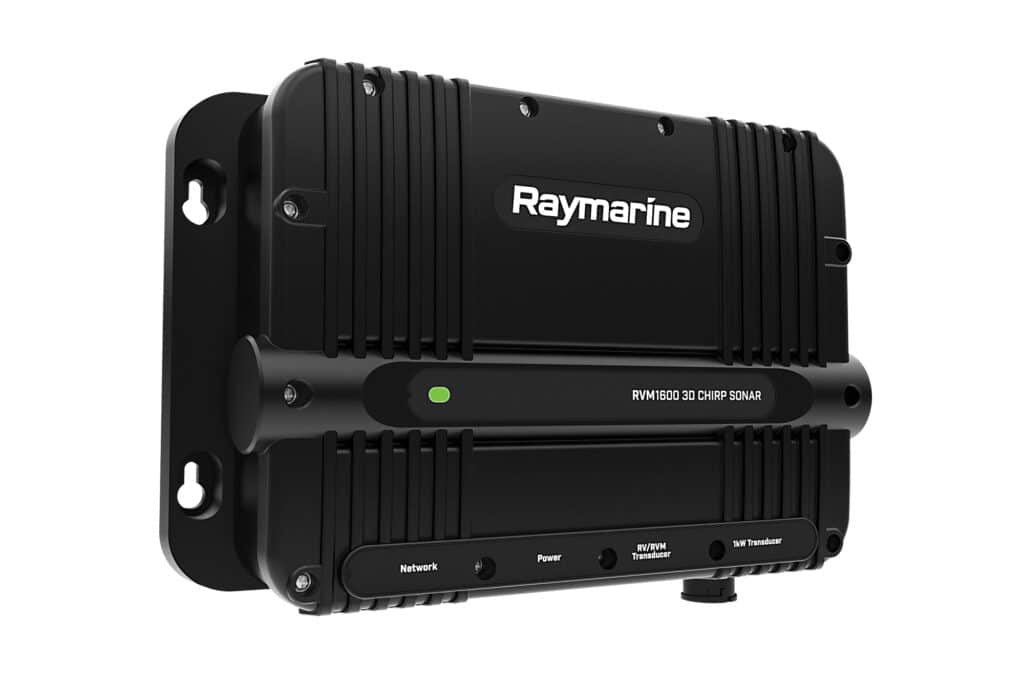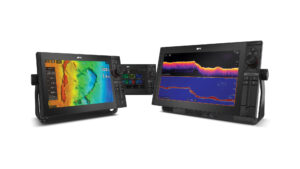
The skies darkened fast. Capt. Art Sapp was runnng home to Lighthouse Point, Florida, from the Bahamas aboard Native Son, his SeaVeei 39, when he saw the storm wall. “I ran 30 miles to get around the thunder and lightning,” he said, adding that he used dual 16-inch Raymarine Axiom 2 XL multifunction displays, and networked radar and satellite weather, to pick a less-awful route. “It’s got a fluidlike feeling on the screens. It’s wild,” Sapp said of the Axiom 2 XL. “It makes it so accurate, there’s no missed touch.”
While screen-tap accuracy matters, there’s more going on with Raymarine’s latest displays than screen coatings. And it’s been developing for years.
In 2017, Raymarine unveiled its Axiom displays with quad-core processors, RealVision 3D sonar and the Android-based Lighthouse 3 operating system. Lighthouse 3 was Raymarine’s all-new operating-system architecture, and it made the company an early Android adopter within the marine space. Raymarine’s Axiom 2 displays come in three models with screen sizes ranging from 9 to 24 inc hes. All of them have six-core processors, global navigation satellite system receivers, 64 gigabytes of solid-state storage, the latest version of Raymarine’s Lighthouse 4 operating system and next-generation screen coatings. The resulting displays, which include angling- and cruising-specific versions, can give boaters better speed, power and improved user interfaces.
The Axiom 2 family starts with Axiom 2 Pro S (from $3,050), which is available in 9-, 12- and 16-inch screens. It comes with a single-channel, chirp-enabled sonar.
“The Axiom 2 Pro S is targeted at cruising boats,” says Jim McGowan, Raymarine’s Americas marketing manager. “It’s got our HydroTough coating on the glass. It’s a nano coating that bonds with the glass on a molecular level. Your fingers just glide smoothly over it, which enhances the functionality.”
In addition, the Axiom 2 Pro S, along with the fishing-specific Axiom 2 Pro RVM, uses Raymarine’s HybridTouch user interface, which employs a touchscreen as well as hard-button-and-knob keypads. Those can be helpful when the seaway starts sloshing the coffee.
RVM stands for RealVision Max sonar. Axiom 2 Pro RVM displays are identical to the Axiom 2 Pro S, save for their sonars. While the Axiom 2 Pro S has a conical chirp-enabled sonar, RVM models (from $2,750) are built with a 10 kW, dual-channel chirp sounder and a 600-watt RealVision Max high multibeam chirp sonar.
“It’s definitely targeted at the hard-core fishermen,” McGowan says, adding that RVM displays deliver chirp DownVision, SideVision, RealVision 3D and high-chirp-sonar perspectives, plus the traditional dual-channel 1 kW chirp sonar.
Given that there are three bands of chirp—low, medium and high—anglers can cover all three bands with an Axiom 2 Pro RVM that’s networked to a Raymarine RVM transducer and to an Airmar low- and medium-frequency chirp transducer.
Axiom 2 displays employ different transducers (sold separately) than previous-generation Axiom offerings. These transducers have piezoceramic elements inside that are larger, McGowan says. Larger ceramic elements equate to greater acoustic sensitivity and better beam-shaping capability. While those features are beneficial, the reality is that boaters need to add the new transducers in order to realize the system’s full acoustic capabilities.
Axiom 2 XL is the most recent addition to Raymarine’s display family. As the name portends, the premium-level XL models (from $7,800) are designed for use in an all-glass bridge aboard large yachts or high-end center-consoles. The touchscreen displays are available in 16-, 19-, 22- and 24-inch glass. While they don’t include an embedded sonar or hard-button controls (owners can add a Raymarine RMK-10 keyboard), they do have HDMI input and output capabilities.

“They have a pretty robust video input and output,” McGowan says. “It’s unique to that level of Axiom. The standard Axioms don’t have it.”
This functionality allows Axiom 2 XL owners to add a Raymarine RVM1600 black-box sonar ($2,000), creating a setup that gives Axiom 2 XLs the same fish-stalking capabilities as Axiom 2 Pro RVMs, just with more-spacious glass.
These HDMI capabilities also allow Axiom 2 XL owners to network a touchscreen-compatible personal computer to their display via a USB connection, and to drive their computer using Axiom 2 XL’s touchscreen pass-through interface. Additionally, the HDMI input and XL-size glass can be used to stream satellite TV or other content.
While each Axiom 2 model has its sweet spot of capabilities, all three models share important DNA. “Because of the six-core processors, the ability to pan across a chart or to zoom in or zoom out, it is very, very snappy,” McGowan says. “The pinch-to-zoom feature is immediate. You’re never waiting for anything to load.”
And the latest version of Raymarine’s Android-based Lighthouse 4 operating system lets third-party software developers create vetted apps that run on Axiom 2 displays.
“We curate the apps that we allow. They have to be largely navigation-focused,” McGowan says, adding that some apps are validated by Raymarine, while others are developed with a partner agreement. “The Android platform gives us the flexibility to do that because there are so many marine devices that are built on or around Android.”
Another benefit of Lighthouse 4’s Android-based architecture, McGowan says, is that navigation software isn’t a heavy lift for the processors: “You’re not really pushing the limits of the hardware out of the box, so that gives us the ability to keep developing new features and new innovations and adding more stuff into the code. We still haven’t even begun to stress the limits of the processor and memory.”
As far as Axiom 2’s pros and cons, the positives are plural, while the drawbacks are largely limited to costs (including installing the larger transducers) and the fact that Raymarine no longer allows owners to pilot DJI Mavic drones from Axiom displays.
But if you’re more concerned with cruising, fishing or creating a premium-level all-glass bridge, then Axiom 2 could be the logical next addition to your yacht’s helm.
Pro Moves
Raymarine’s RVM1600 sonar module can be networked with an Axiom 2 XL to yield the same sonic capabilities as an Axiom 2 Pro RVM.
Sky-Talker
Axiom 2s are agnostic about satellite-communications connections. They play nicely with mazu’s M2500 ($1,100), which uses Iridium’s global, short-burst data service to provide weather, email, SMS messaging and an optional sport-fishing app. It appears as an app, so users can see it on Axiom’s sunlight-readable screen.









